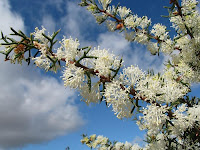Honey Bush - Hakea lissocarpha
Many white flowering hakeas can be so highly (honey) perfumed, as to be almost overpowering and Hakea lissocarpha for this very reason has the apt common name of Honey Bush. It is a spreading shrub usually between 1 and 1.5 metres (3'-5') in height; the branches even the small ones are quite rigid, so too are the very sharp tipped leaves; so if you try to push it aside you are met with stiff resistance allowing the needle sharp leaves to easily penetrate your skin. Nevertheless, I find the arching habit of these plants structurally appealing and the intricately divided leaves engaging. The flowers of the Honey Bush bloom on mass thereby providing a softening white blanket amongst the spines, which strangely may help protect pollinating insects from bird predators who would have great difficulty landing without injuring themselves.
The seed capsules or 'fruits' are closely attached to the branches and although some remain intact for several years, many will open to release the seed and eventually fall to the ground. The botanical name ' lissocarpha' actually refers to the external smooth surface of the fruits. The preferred habitat in the Esperance region for this species is low-lying sandy areas with a shallow gravel/clay substrate, making it a little boggy during wet weather. The outer edges of granite outcrops is another place where it can be found. A widespread plant but more common in farming districts from near coastal to the southern edge of the inland limestone substrate mallee region. Flowering can occur anytime from May to September.







